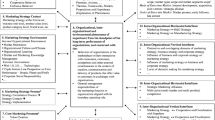Abstract
The push-pull framework provides a useful approach for examining the tourist motivation. This paper takes the world heritage—Huangshan Mountain as a sample. From the two different aspects of pull and push factors, the underlying features of visitors’ motives to Huangshan Mountain are analyzed with the help of factor analysis. As a result, five push factors and four pull factors are identified. Further analyses investigate differences in the push and pull factors among different socio-demographic subgroups with one-way ANOVA analysis. The result of the study affords us useful references for development, protection and marketing expansion of mountain resorts.
Similar content being viewed by others
References
BOTHA C, CROMPTON J L, KIM S, 1999. Developing a revised competitive position for Sun/Lost City, South Africa [J]. Journal of Travel Research, 37(2): 341–352.
CHA S, MCCLEARY K W, UYSAL M, 1995. Travel motivations of Japanese overseas travelers: a factor-cluster segmentation approach [J]. Journal of Travel Research, 33(2): 33–39.
CROMPTON J L, 1979. Motivations for pleasure vacations [J]. Annals of Tourism Research, 6(4): 408–424.
DANN G M S, 1977. Anomie, ego-enhancement and tourism [J]. Annals of Tourism Research, 6(4): 408–424.
DANN G M S, 1977. Anomie, ego-enhancement and tourism [J]. Annals of Tourism Research, 4(4): 184–194.
DANN G M S, 1981. Tourism motivation: an appraisal [J]. Annals of Tourism Research, 8(2): 187–219.
FAKEYE P C, CROMPTON J L, 1991. Image differences between prospective, first time, and repeat visitors to the Lower Rio Grande Valley [J]. Journal of Travel Research, 29(1): 10–16.
HU Y, RITCHIE J R B, 1993. Measuring destination attractiveness: a context approach [J]. Journal of Travel Research, 32(2): 25–34.
ISO-AHOLA S E, 1982. Toward a social psychological theory of tourism motivation: a rejoinder [J]. Annals of Tourism Research, 9(2): 256–262.
ISO-AHOLA S E, 1989. Motivation for leisure [A]. In: JACKSON E L, BURTON T L (eds.). Understanding Leisure and Recreation: Mapping the Past Charting the Future [C]. State College, PA: Venture Publishing, 247–279.
KIM S, CROMPTON J L, BOTHA C, 2000. Responding to competition: a strategy for Sun/Lost City, South Africa [J]. Tourism Management, 21(1): 33–41.
KIM S, LEE C, KLENOSKY D B, 2003. The influence of push and pull factors at Korean national parks [J]. Tourism Management, 24(2): 169–180.
KLENOSKY D B, 2002. The pull of tourism destinations: a means-end investigation [J]. Journal of Travel Research, 40(4): 385–395.
NUNNALLY J C, 1978. Psychometric Theory [M]. Second Edition. New York: McGraw-Hall.
OH H C, UYSAL M, WEAVER P A, 1995. Product bundles and market segments based on travel motivations: a canonical correlation approach [J]. International Journal Hospitality Management, 14(2): 123–137.
PEARCE P L, CALTABIANO M, 1983. Inferring travel motivations from travelers’ experiences [J]. Journal of Travel Research, 22(2): 16–20.
PYO S, MIHALIK B J, UYSAL M, 1989. Attraction attributes and motivations: a canonical correlation analysis [J]. Annals of Tourism Research, 16(2): 277–282.
TURNBULL D R, UYSAL M, 1995. An exploratory study of German visitors to the Caribbean: push and pull motivations [J]. Journal of Travel and Tourism Marketing, 4(2): 85–92.
UYSAL M, HAGAN L A R, 1993. Motivation of pleasure travel and tourism [A]. In: KHAN M, OLSEN M, VAR T (eds.). Encyclopedia of Hospitality and Tourism [C]. New York: VNR, 798–810.
UYSAL M, JUROWSKI C, 1994. Testing the push and pull factors [J]. Annals of Tourism Research, 21(4): 844–846.
YUAN S, MCDONALD C, 1990. Motivational determinants of international pleasure time [J]. Journal of Travel Research, 24(1): 42–44.
ZHANG Q H, LAM T, 1999. An analysis of Chinese mainland visitors’ motivations to visit Hong Kong [J]. Trourism Management, 20(1): 587–594.
Author information
Authors and Affiliations
Additional information
Foundation item: Under the auspices of the National Social Science Foundation of China (No. 03BJY084)
Biography: WANG De-gen (1973-), male, a native of Huangshan of Anhui Province, lecturer, specialized in tourist market and tourist planning. E-mail: dgwang73@263.net
Rights and permissions
About this article
Cite this article
Wang, Dg. Push-pull factors in mountain resorts. Chin. Geograph.Sc. 14, 368–376 (2004). https://doi.org/10.1007/s11769-004-0043-x
Received:
Issue Date:
DOI: https://doi.org/10.1007/s11769-004-0043-x




